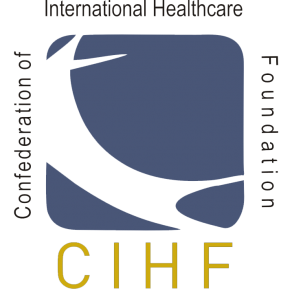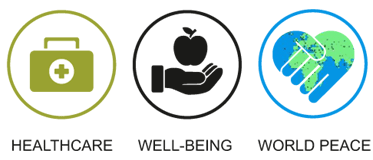• To improve Quality of Healthcare.
Research shows that even though there are well developed, widely accepted methods for treatment, many patients are not getting care based on these medical guidelines. CIHF helps to resolve the issues that keep many Indian patients from receiving care based on the best available science and practice.
• To Promote India as preferred healthcare destination.
Medical tourism in India has a potential to attract 1 million tourists per annum, contributing up to $5 billion. To create a common platform for all the leading & branded healthcare organisation, hospitals, Path-Labs, Doctors, Government bodies, Hotels & Tour operators to come and join hands together to develop & promote Indian Health Tourism and leading it to achieve great heights.
• To strengthen the capacity of hospitals, emergency providers, and nursing homes to serve the public.
India’s growing population needs a reliable, affordable, quality system of hospital, emergency, and nursing home care. CIHF is committed to helping these institutions improve the availability and quality of care and services in ways that address the broader interests of the public.
• To help health insurance better serve the public.
Health insurance is a critical issue for all Indians. CIHF works to increase access to insurance for those who don’t have coverage and help the market work better for those who do.
• To improve India’s public health care financing and policy.
Decisions about public financing and policy affect India’s most vulnerable populations, as well as most health care institutions and insurers. CIHF works to create solutions to problems in publicly funded health care and safety net programs.
CIHF has developed particular skills and knowledge in two domains: health information technology, consumer information, and publishing and communications. These domains, which we call Areas of Strategic Emphasis, work across the Foundation, collaborating with the programs, to achieve our objectives. Health Information Technology looks for ways that information technology can help solve problems identified by our programs. Publishing and Communications ensures that we effectively reach our target audiences with messages and products that are useful and meaningful to them.
Quality Healthcare for people
CIHF wants to improve the safety and quality of care in Indian community through the provision of education, publications, consultation, evaluation & accreditation services. Research shows that even though there are well developed, widely accepted methods for treatments, many patients are not getting care based on these medical guidelines.
CIHF seeks to improve the health of Indians by working to ensure that patient gets care that is based on the best scientific knowledge. The Program’s goals are to:
• Help providers (in Hospitals, physician offices, clinics, and medical groups) redesign clinical practice to provide effective care for patients.
• Help bring health care systems into the 21st century by guiding the use of health information technology in the management.
• Create an environment; in both the public and private sectors, that promotes quality care.
CIHF continuously fosters relationships with its Indian partners, including physicians, hospitals, medical groups, safety-net providers, health plans, employers, regulators, and consumers to realise positive health outcomes for improving quality healthcare in India.
India as Preferred Health Tourism Destination
CIHF wants that “India must leverage its competitive edge, specially the cost advantage which is only one fifty of medical costs in the West. A heart surgery in the US costs $30,000 while it costs $ 6,000 in India. Bone marrow transplant in the US costs $2,50,000 while it is $26,000 in India”. CIHF looks at India’s unique position in the holistic medicinal service. “With yoga, meditation, ayurveda, allopathy, and other systems of medicines, India offers a unique basket of services to an individual that is difficult to match by other countries”.
• At the current pace of growth, healthcare tourism alone can rake in over $2 billion as additional revenue by 2012.
• Healthcare spending in the country will double over the next 10 years.
• Private healthcare will form a large chunk of this spending, rising from Rs 690 billion ($14.8 billion) to Rs 1,560 billion ($33.6 billion) in 2012.
• This figure could rise by an additional Rs. 390 billion ($8.4 billion) if health insurance cover is available to the rich and the middle class.
• Voluntary health insurance market is estimated at Rs. 4 billion ($86.3 million) currently but is growing fast. Industry estimates put the figure at Rs. 130 billion ($2.8 billion) by 2005.
With the expected increase in the pharmaceutical market, the total healthcare market could rise from Rs 1,030 billion ($22.2 billion) currently (5.2 percent of GDP) to Rs. 2,320 billion ($50 billion)-Rs 3,200 billion ($69 billion) (6.2-8.5 percent of GDP) by 2012.
(Source CII & McKinsey Report)
Strengthening Hospitals & Nursing Homes
India’s growing population needs a reliable, affordable, quality system of hospital, emergency, and nursing home care. But hospitals and nursing homes face a myriad of demands and challenges. They are responsible for taking care of the sickest and most vulnerable patients and are the most costly components of the health care system. Beyond providing care, hospitals are the central repository for the latest diagnostic and surgical technology, training ground for physicians, nurses, and other health professionals, and the site for much medical research. Many hospitals and nursing homes are financially strapped. Even those with healthy bottom lines face problems with staffing, updating facilities, and safety issues.
CIHF Hospitals and Nursing Homes Program is committed to helping these institutions improve the availability and quality of care and services in ways that address the broader interests of the public. The Program’s work aims to:
• Support the viability and affordability of Indian hospitals;
• Promote public accountability and provide feedback on the performance of hospitals and nursing homes; and
• Help ensure the long-term availability and effective use of health care workers in hospitals and nursing homes.
Helping Health Insurance to grow
Health insurance is important to all Indians. Those who have insurance are increasingly concerned about the cost and benefits included in their coverage; those who do not have insurance may have more trouble getting medical care and their health may be poorer than those who are insured. Health insurance is a major issue for policymakers who must deal with market regulation and coverage expansion. Finally, the design and regulation of insurance products can significantly influence health care quality and costs for businesses and consumers, as well as affect providers.
CIHF Health Insurance Program works to serve the public by increasing access to insurance for those who don’t have coverage, and helping the market work better for those who do. The Program’s work is aimed at:
• Helping consumers make decisions about health insurance.
• Supporting efforts to expand health insurance to uninsured Indians.
• Fostering informed public and private sector decision-making toward expanding and improving coverage.
• Focusing stakeholder attention on tradeoffs among cost, benefits, and coverage.
CIHF has studied the problems and potential solutions to health insurance issues. It has a solid understanding of India’s uninsured population and insurance markets, as well as a reputation for providing credible, unbiased information and forums for discussion. This Program works with policymakers and regulators, Government, state and local agencies, health plan and insurance industry experts, consumer advisory groups, researchers, and others to meet its goals.
Improve Public Financing & Policy
Public financing and policy decisions affect millions of people and nearly all health care institutions in India. A wide range of financial, organisational, and regulatory barriers make it difficult for government to administer publicly funded health care programs efficiently and effectively. Cost containment pressures at the local, state, and national government levels threaten the stability of health care resources on which all Indians depend, including nursing homes, emergency rooms, and safety net providers. Those most affected are the low-income, elderly, chronically ill, and uninsured.
CIHF Public Financing and Policy Program work to create solutions to problems in publicly funded healthcare and safety net programs by:
• Developing specific interventions to improve operations and financing of publicly funded health programs and institutions.
• Providing timely, meaningful information and analysis to influence public financing and policy decisions on important issues affecting health care in India.
• Creating and moving policy solutions through trusted relationships between CIHF and decision-makers.
Health Information Technology
Health Information Technology supports the goals and objectives of CIHF programs through development of information technology solutions.Health Information Technology’s work involves:
• Designing, building, and promoting the adoption of applications that streamline enrollment processes and improve access to care.
• Introduction of Electronic Health Records & Maintenance.
• Developing and implementing data standards and automated information processes that support improvements in care delivery for people with chronic diseases.
• Researching and reporting on new developments and trends in the use of Internet and other information technologies aimed at improving the quality and safety of care.
CIHF have helped to accelerate the adoption and use of new information technologies in health care, and enabled public and private health care organisations to realise the potential of the Internet for improving clinical and business practices through better communication and access to information.
Publishing & Communications
Publishing and Communications supports CIHF programs and the work of Consumer Information and Health Information Technology by ensuring that they reach target audiences with effective messages and products. Publishing and Communications’ work involves:
• Producing high-quality print and online publications that meet the needs of target audiences.
• Building and maintaining distribution networks through relationships with community organisation, consumer and advocacy groups, media outlets, and health care institutions.
• Assisting in identifying audiences, their needs, and the best way to serve them.
Creating methods to reach the right people with the right messages at the right time.




